The 2013 Mobile World Congress (MWC) is without a doubt a very, very large show – with mobility sizzling hot, it’s no small wonder the show continues to grow in size and importance. Usually, we’re able to uncover some set of significant announcements – and there certainly were some to be had, just not on the smartphone or tablet front.
In our humble opinion, among the entire collection of giant-sized smartphones and small tablets announced this year, there were simply none we would peg as significant.
HTC was right to jump the gun and announce its new flagship HTC One ahead of MWC – in our opinion it more than set the bar for what everyone else needed to deliver on and no vendor managed to do so. Meeting that bar would have required a combination of high end build quality and design, some software touches that ensured there would be no “Androidy” look and feel, and some additional technology “newness.”
The HTC One delivers all of this – nothing on exhibit at MWC did.
We will note one exception, generally speaking, that being Yota Devices' YotaPhone – which we’ve covered separately. The YotaPhone offers a unique variation on the everyday smartphone even though in and of itself it is still just another Android phone underneath its special dual display skin.
Kudos do go to Nokia for not introducing a ridiculously fat (or phat or phab) new smartphone. Nokia spent its time at the show filling in underneath its Nokia Lumia 920 and 820 devices. We know the company is working on its next generation state of the art smartphone, and it should also have some laptop to show off soon…maybe – but neither was even hinted about at MWC. That said we’ll start our MWC roundup with Nokia.
Lumia 720 and 520…and the 105 and 301
Yes those last two are certainly odd numbers - they harken back to a different and perhaps more “golden” age of Nokia, and we’ll come back to them. But first…
Nokia announced two very nice new additions to the now quite recognizable Lumia line-up. They fit directly below the both the 920 and 820 and the goal for both Nokia and Microsoft is to begin opening up the lower end of the smartphone market with them. We wouldn’t call them “budget” smartphones exactly – they are a step above.
Both support wireless charging and are able to run Nokia’s music and mapping services, though neither supports LTE.
- The 720 is a 3G device that delivers a 4.3 inch WVGA display offering 800 x 480 pixel resolution, a 6.7 megapixel camera, albeit one that comes with a “Carl Zeiss Tessar” lens – though we’re not sure this makes any real difference. It also includes a 1.3 megapixel front-facing camera. A dual-core Snapdragon S4 processor clocked at 1.0 GHz runs the software, and the device provides 512 MB of RAM and 8 GB storage. There is also a very welcome SD card slot – so more storage is always available to be had. The 720 should be available before March 2013 is out and will retail for 249 Euros ($326).
- The 520, also a 3G device, has a 4 inch display (same as the iPhone 5) offering a resolution of 800 x 480-pixels. It has a 5-megapixel camera, and the same dual-core 1.0 GHz Snapdragon S4 processor, 512MB of RAM, 8GB of internal storage and a micro SD card slot. The retail cost is a mere 139 Euros ($182)
The low end doesn’t stop there however. Does anyone remember “candy bar” mobile phones? It was a term applied to many of Nokia’s old narrow non-flip devices that have a small screen and old fashioned phone keypads (so you do remember…). Well, that is what the 105 and the 301 are all about. They are the first two devices pictured below.
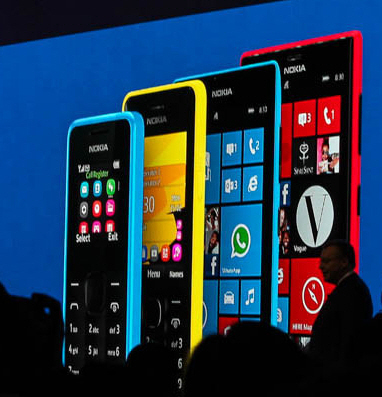
Some old feature phones also had something none of today’s smartphones have – tremendously long battery life, and Nokia delivers on this. The 105, for example, may not need more than a one time a month charge.
- The 105 retails for all of 15 Euros ($20!). Nokia is truly moving to deliver feature phones at more or less bargain basement prices (likely free to users in many cases depending on carrier subsidies). It comes in a bold range of colors – cyan and black. Cyan is an old Nokia standby totally appropriate for this class of device.
- The 301 is due to go on sale in Q2 2013 and will retail for 65 Euros ($85). The 301 offers 3.5G connectivity, delivers a 2.4 inch display, a 3.2 megapixel camera and runs the Nokia Xpress Browser (truly old school but for its intended audience likely cutting edge). It too offers a range of colors, but those extra dollars get you cyan, black, magenta, yellow, and white.
These phones will specifically target emerging countries and markets - China, Egypt, India, Indonesia, Nigeria, Russia, Vietnam and other markets in Africa, the Middle East, Asia-Pacific and Europe will all see these phones. This is a return for Nokia to where its old bread and butter used to be – they are market segments where even the cheapest Android phone is likely to be expensive. For these markets even a once a month charge may be a difficult cost to meet. The tradeoff for Nokia? Volume. Nokia can easily sell many millions of these babies.
ZTE’s Grand Memo
The name says it all - "Grand" = large size, and "Memo" = Note (as in the Samsung Note). Which in turn means that the ZTE Grand Memo is meant to compete with the Galaxy Note 2 specifically, as well as with the other devices that are now starting to clog this market segment.
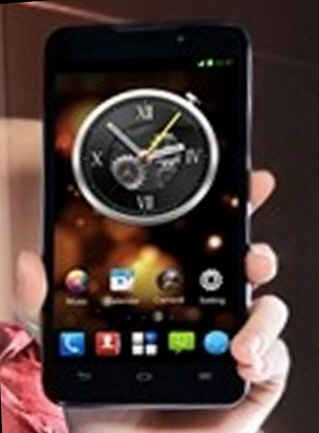
Somehow, "phablet" seems an appropriate term for this device. We hope ZTE's marketing department wasn't strained by the branding effort. The Grand Memo offers a 1,280 x 720 pixel display, 2 GB of RAM, and a 13 megapixel rear camera - all housed in a package that is just under 9 mm thick. The camera's pixel count certainly sounds high end, but much depends on how the device makes use of all those pixels - improper design will need to less rather than higher quality and we simply don't know which it will prove to be at this point.
The Grand Memo uses Qualcomm's new Snapdragon SoC 800 chipset - and it is apparently the first mobile device to do so. It is quad-core and has a 1.5 GHz clock speed. At this point in time that horsepower will be managed by Android Jelly Bean 4.1.2.
ZTE is a Chinese vendor and more than likely the company will launch the device primarily within this market though we have to wonder just how much of a market there is in China for it. ZTE could look to deliver outside of China on a cost differentiator to global carriers, but whether or not a user market for it develops is a significant issue. Would we consider it instead of an HTC DNA? Likely not.
LG 's Optimus G Pro
And so we are with LG's version of a large smartphone. As it happens, the Optimus G Pro will be built in two sizes - a 5 inch display version will target Japan while a slightly larger 5.5 inch display version will ship everywhere else, including in North America. Half an inch may not sound like much but it adds to the size overall in tangible ways.
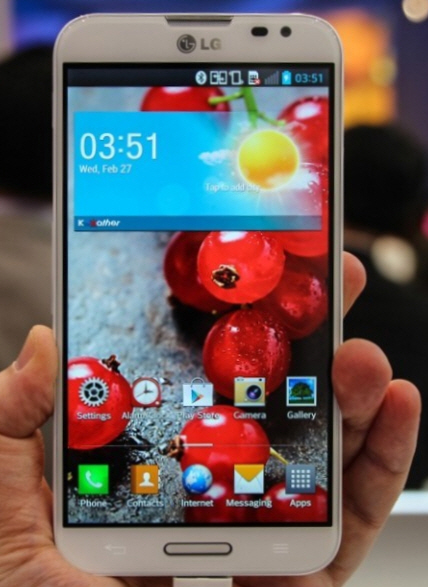
Regardless of actual size, the new device will deliver on a 1,920 x 1,080 HD display (which bestows upon the ZTE Grand Memo major second rate status), with a screen resolution of 400 ppi. The Qualcomm quad-core Snapdragon 600 processor clocked at 1.7 GHz powers Android Jelly Bean 4.1.2. NFC capability is provided, and as is the case with the ZTE device, the Optimus G Pro also sports a 13 megapixel camera - our caveat for the ZTE applies here as well. A front facing 2.1 megapixel is part of the package. The battery on this device is removable and also hefty at 3,140 mAh.
The Optimus G Pro is about 1 mm thicker than that ZTE, and is cased in plastic - hardly cutting edge or an otherwise cool visual design. It also sports LG's standard UI, which isn't saying much. It doesn't not look like a Samsung Note, and plastic is plastic - it may keep the cost down but it isn't to our liking - though that is nothing more than a personal choice - others we know love and prefer the plastic.
Huawei Ascend P2 - World's Fastest 4G at 150 Mbps?
At last year's MWC Huawei unveiled what it claimed was at the time the world's fastest tablet. We've since heard nothing more about that device, and being labeled "world's fastest" didn't serve as much of a differentiator. Of course at the time Huawei was just getting started with its mobile device efforts and had a long way to go to break into the club.
This year Huawei has yet another world's fastest to offer, this time focusing on wireless speed - the new Ascend P2. Scheduled to launch during summer 2013, the new smartphone uses LTE category 4 and Huawei claims to be able to achieve wireless speeds up to 150 Mbps. It also supports HSDPA at 42 Mbps. It's impressive - and Internet/Web access would certainly be crisp - but we're hard pressed to see where it would be deployed to make any of it a mainstream reality. Japan or South Korea perhaps, but we don't see Huawei making any inroads what so ever in either country.

The P2, with its decided sharply squared edges, is part of what Huawei refers to as its "fashion-focused product range" and the company refers to the screen details as its "infinity pool" design. This refers to actual infinity swimming pools which appear to have no edges or boundaries. The package overall is quite slim at 8.4 mm and in truth the design is quite appealing.
The P2 makes use of a 4.7 inch 720x1,280 pixel display with 315 ppi resolution. Certainly not small, but also not terribly large - a Note 2 competitor it isn't - rather it strives to compete with today's crop of large high end smartphones. Powered by a 1.5 GHz quad-core processor, the P2 delivers 1GB of RAM and runs Android Jelly Bean 4.1. A 2,420 mAh battery (for which Huawei claims both an improved charge time as well as longer life per charge) and NFC complete the internals. The P2 also moves up to a 13 megapixel camera, but again the caveat here is that more pixels don't mean better photos. There is also a 1.3 megapixel front camera.
All in all the Ascend P2 is an excellent device. It breaks no new ground but can be a nice alternative - at the right subsidized price point. Or perhaps it can offer carriers such as T-Mobile a cool high end device that won't cost subscribers a lot of dollars within T-Mobile's new unsubsidized business approach.
ASUS PadFone Infinity
It is possible that many among us that live in North America don't know much about the PadFone line. That is understandable since Asus doesn't sell it outside of Europe or Asia, but the newly announced PadFone Infinity is worth noting in any case.
After our Huawei detour, we're now back to the giants among smartphones - and in the case of the Asus Padfone Infinity, things become even more gigantic if so desired. How so? Well, all Padfones are designed to be able to slide into a docking station that in turn offers a far larger tablet screen capability - in the case of the Infinity the tablet measures out to a 10.1 inch display . The image below shows how Asus accomplishes this.
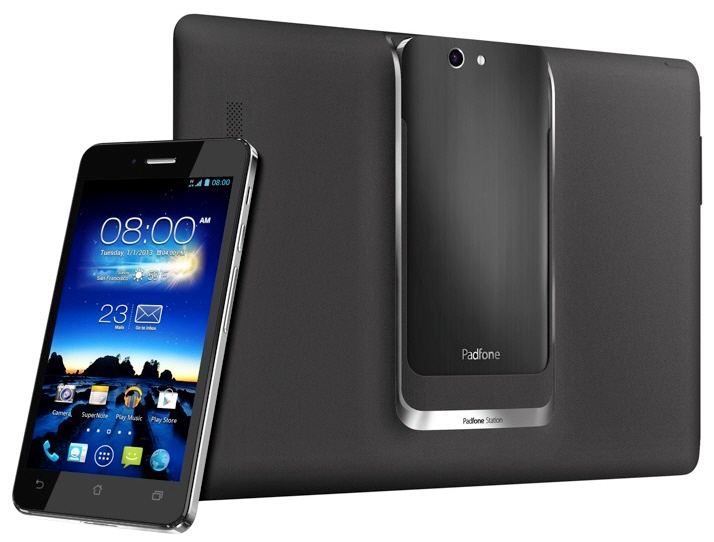
The PadFone Infinity runs Android Jelly Bean 4.2, and the Infinity version of the PadFone lineup moves from a 4.7 inch to 5 inch display, putting it firmly in Galaxy Note 2 territory. Video resolution is now bumped up to full 1080p from the 720p of earlier versions and now delivers 441 pixels per inch screen resolution.
The Infinity is powered by Qualcomm's quad-core Snapdragon 600 clocked at 1.7 GHz. It also happens to sport Qualcomm's Adreno 320 GPU. There are 2GB of RAM along with either 32 GB or 64 GB of storage. NFC is supported and the device comes with a 2,400 mAh battery. And - surprise - ASUS has also moved up to 13 megapixel camera. There is a 2 megapixel front camera as well.
When docked to the tablet screen, the user ends up with a 10.1-inch tablet with a resolution of 1,920 x 1,200 - which is greatly improved from the earlier version's 1,280 x 800. The dock does also provide its own 5,000 mAh battery, but aside from and the larger screen the user doesn't actually get much else out of the docking capability. The combination will, unfortunately, likely cost as much as a powerful new Windows 8 Ultrabook and offer none of the benefits.
Samsung's Galaxy Note 8.0 - A Phone Larger than Life!
There has already been a lot written about the Galaxy Note 8.0. As the numbering scheme suggests, it is larger than the company's small Tab (7 inches), and smaller than Samsung's large Tab (10.1 inches). In fact its size places it…right there with the iPad Mini - now that is truly an amazing and extraordinary coincidence. Below is an image - and yes it certainly looks like a Galaxy device.
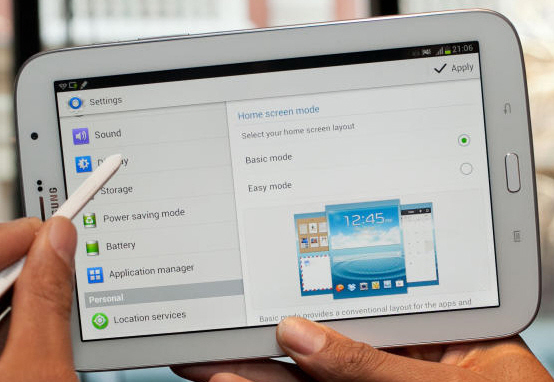
Note the name of the beast as well - it isn't a Tab - it is specifically a Galaxy. So there are some interesting Samsung branding strategies in play. What's more, as it is dubbed a Galaxy, and as the Galaxy refers to the company's smartphones - guess what? On the very off chance you haven't yet heard, the Galaxy 8.0 is indeed also a phone! A very giant of a smartphone. And therein lies a key differentiator for Samsung - or so it believes - relative to competing with the iPad Mini - which sports LTE but is most definitely not a phone and cannot be used as such. Below is what it looks like as a…phone! Seriously.
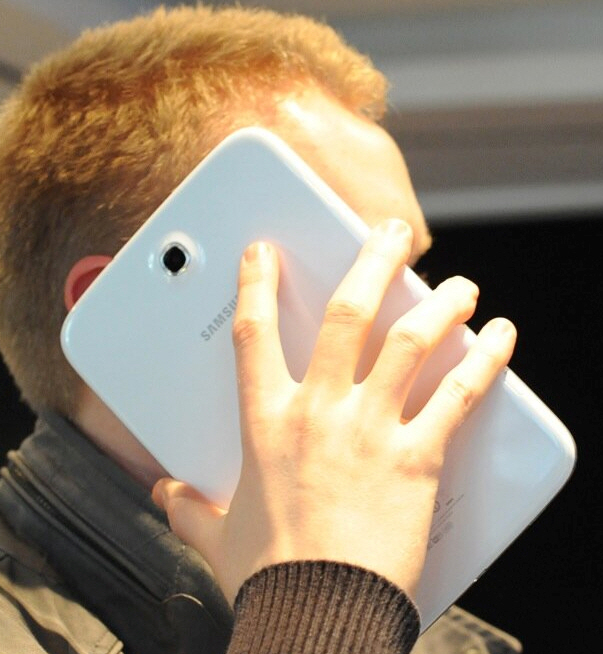
The Galaxy Note 8.0 runs Android Jelly Bean 4.1.2 and of course features Samsung's TouchWiz user interface - though we wonder if the current TouchWiz device crash problem will be fixed as part of its release. The display measures 8 inches diagonally and but only delivers 1,280x800 resolution (the same as the Galaxy Note II). It uses a 1.6 GHz quad core processor and provides 2 GB of RAM, along with either 16 GB or 32 GB of storage. It does support a microSD card - always a useful thing. A 5-megapixel camera that can record 1080p HD video is provided, as well as 1.3-megapixel front camera.
As with the Galaxy Note II, the Note 8.0 delivers on stylus support. We don't know how many casual consumer users put the stylus to use, but it does have a place in the workplace and may prove an interesting differentiator for certain types of field service operations. Maybe.
Edited by
Braden Becker